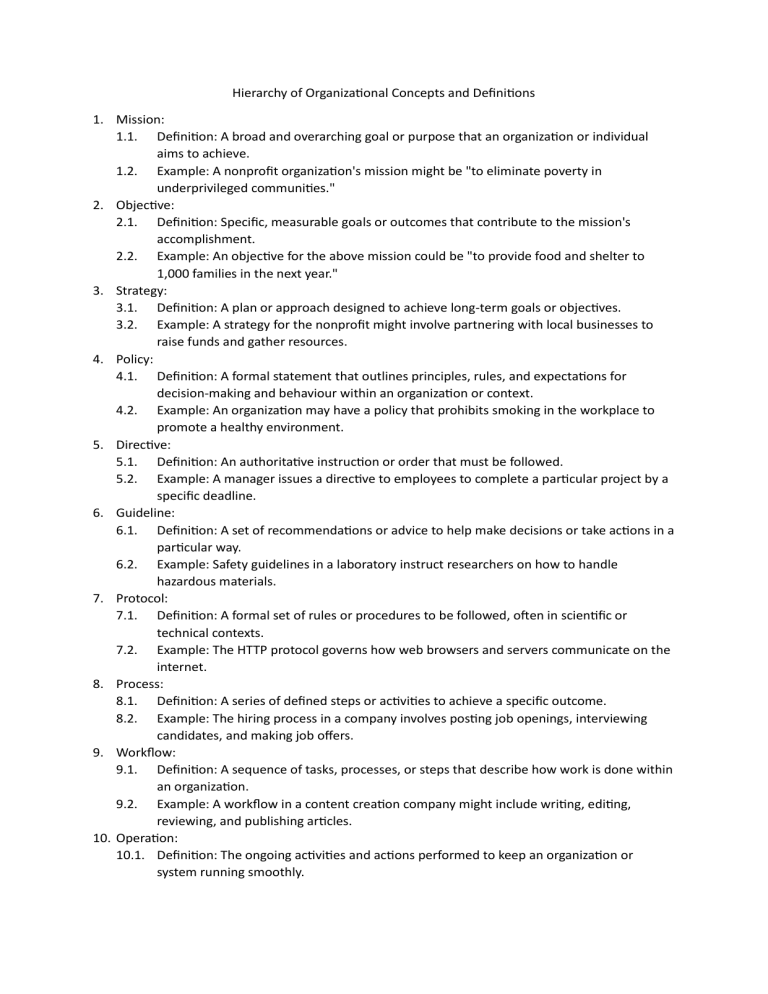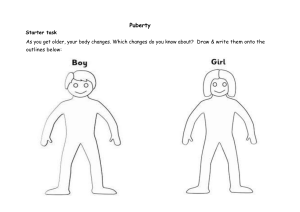
Hierarchy of Organizational Concepts and Definitions 1. Mission: 1.1. Definition: A broad and overarching goal or purpose that an organization or individual aims to achieve. 1.2. Example: A nonprofit organization's mission might be "to eliminate poverty in underprivileged communities." 2. Objective: 2.1. Definition: Specific, measurable goals or outcomes that contribute to the mission's accomplishment. 2.2. Example: An objective for the above mission could be "to provide food and shelter to 1,000 families in the next year." 3. Strategy: 3.1. Definition: A plan or approach designed to achieve long-term goals or objectives. 3.2. Example: A strategy for the nonprofit might involve partnering with local businesses to raise funds and gather resources. 4. Policy: 4.1. Definition: A formal statement that outlines principles, rules, and expectations for decision-making and behaviour within an organization or context. 4.2. Example: An organization may have a policy that prohibits smoking in the workplace to promote a healthy environment. 5. Directive: 5.1. Definition: An authoritative instruction or order that must be followed. 5.2. Example: A manager issues a directive to employees to complete a particular project by a specific deadline. 6. Guideline: 6.1. Definition: A set of recommendations or advice to help make decisions or take actions in a particular way. 6.2. Example: Safety guidelines in a laboratory instruct researchers on how to handle hazardous materials. 7. Protocol: 7.1. Definition: A formal set of rules or procedures to be followed, often in scientific or technical contexts. 7.2. Example: The HTTP protocol governs how web browsers and servers communicate on the internet. 8. Process: 8.1. Definition: A series of defined steps or activities to achieve a specific outcome. 8.2. Example: The hiring process in a company involves posting job openings, interviewing candidates, and making job offers. 9. Workflow: 9.1. Definition: A sequence of tasks, processes, or steps that describe how work is done within an organization. 9.2. Example: A workflow in a content creation company might include writing, editing, reviewing, and publishing articles. 10. Operation: 10.1. Definition: The ongoing activities and actions performed to keep an organization or system running smoothly. 11. 12. 13. 14. 15. 16. 10.2. Example: The day-to-day operations of a retail store include stocking shelves, assisting customers, and processing sales. Task: 11.1. Definition: A specific piece of work or activity to be completed. 11.2. Example: Writing a report on market research findings is a task assigned to an employee. Step: 12.1. Definition: An individual action or phase within a process or procedure. 12.2. Example: In a recipe, each instruction, like "chop vegetables," represents a step. Checklist: 13.1. Definition: A list of items or tasks to be checked off or completed. 13.2. Example: A pilot uses a pre-flight checklist to ensure that all necessary safety measures are in place before take-off. Schedule: 14.1. Definition: A plan that outlines the timing and sequence of activities or events. 14.2. Example: A project manager creates a project schedule to allocate tasks and set deadlines for team members. Milestone: 15.1. Definition: A significant point or achievement in a project or journey, often used to mark progress. 15.2. Example: In a software development project, a milestone could be the completion of a major feature or module. Method: 16.1. Definition: A systematic way of doing something or achieving a specific result. 16.2. Example: In research, the scientific method involves making observations, forming hypotheses, conducting experiments, and analysing data.



